Introduction
The cashew tree (Anacardium occidentale L.) occupies an important place in the world. Its cultivation developed spontaneously and naturally in South American countries 1. In the tropics, particularly in many parts of Africa and Asia, its presence is attributed to humans 2. Globally, Burkina Faso ranks 12th in production by volume of nuts exported and 5th in cashew nut production in West Africa 3. In Burkina Faso, cashew nuts represent the third largest export product after cotton and sesame, with exports estimated at 117.11 billion CFA francs in 2018 4.
On the nutritional front, several studies have shown significant nutritional benefits from cashew kernel consumption. According to some of these studies, cashew kernels have a high energy value, with important nutrients including fats, proteins, essential fatty acids and certain minerals 5,6,7,8,9. On the health front, studies have reported the beneficial effects of eating nuts such as cashews on human health, notably in preventing and reducing the risk of cardiovascular disease and mortality 10,11, obesity 12, gallstones and colon cancer in women 13.
Cashew kernels are mainly consumed as salty or spicy snacks. In the cookie, pastry and yogurt industries, it can be used in powder, granulated or whole form 14. In Burkina Faso, 90% of cashew nut production is mainly marketed in crude form, and only 10% is processed locally, mainly in the form of whited or cooked kernels. Generally, artisanal or semi-industrial processing follows the same processing diagram. The main processing stages consist of nut embrittlement either by cooking with drained oil or steam, extraction of the kernel by hulling, dehulling and cooking-seasoning15. All these treatments applied to cashew nuts require the input of heat, which could influence the physicochemical and nutritional quality of the kernel, but very few studies have focused on this important aspect. Thus, this study aimed to evaluate the effects of heat treatments on the physicochemical and nutritioncal parameters of cashew kernels from three localities in Burkina Faso.
Materials and Methods
Plant material
The plant material consisted of 9 cashew nut samples randomly collected from three different markets in Banfora, Bobo-Dioulasso and Gaoua in Burkina Faso. The collection criteria were that the nuts should not come from any selection and should be exposed in bulk to have samples under local market conditions. The samples collected were coded, packed in jute bags and sent to the Food Technology Department laboratory for analysis. Figure 1 shows the coding of cashew nut samples.
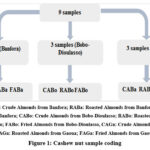 |
Figure 1: Cashew nut sample coding |
Cashew kernel samples processing
Falade’s process 16 was used to obtain fried and roasted almonds, as shown in the diagram in Figure 3. Processing begins by obtaining the edible kernels. Cashew nuts were cut into two halves using pruning shears, and the shells were removed to obtain the edible kernels.
To obtain the crude almonds, the cashew nuts were simply cut without precooking, then the shells were removed. The resulting kernels were then stripped of their protective membranes to obtain untreated crude kernels, which were used as control kernels.
To obtain the treated kernels, the dried healthy cashew nuts were subjected to steam precooking in an oven at 115°C for 45 min (Fig. 2A), followed by drying at room temperature for 48 h (Fig. 2B). The cashew nuts were then shelled manually by dividing them into two halves using pruning shears (Fig. 2C). The shelled kernels were dried in an oven at 85°C for 2 hours before being de-shelled to obtain the whited kernels (Fig. 2D). The dehulled almonds were then dried at 65°C for 6 hours to reduce the moisture content to between 5 and 6% before being roasted or fried. Crude, roasted and fried almonds were ground to powder using an electric grinder (KN 195 Knifetec TM) and then stored for analysis. Figure 3 shows the cashew nut processing stages.
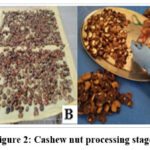 |
Figure 2: Cashew nut processing stages |
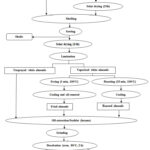 |
Figure 3: Cashew nut processing diagram |
Assessment of physicochemical and nutritional composition and variation rates
The powder obtained was de-oiled in hexane, placed in polyethylene jars and stored in the refrigerator at 4°C for the various analysis.
Nutritional parameters were determined according to official AOAC methods.
Moisture content was determined by differential weighing of a 5 g test sample before and after oven drying at 105°C for 12 h, by the French standard NF V 03-707 (2000).
Ash content was determined by incinerating 5 g of sample in a muffle furnace (Nabertherm) at 550°C for 4 hours, by the international standard ISO 2171 (2007).
The fat content of the samples was determined using the Soxhlet extraction method with hexane as a solvent, by the international standard ISO 659 (1998).
Total protein content was determined by the Kjeldahl method by French standard NF V03-050 (1970).
The carbohydrate content of the samples was determined by the spectrometric method using sulfuric orcinol. Sample absorbance was read at 510 nm using a UNI 002_FR Spectrophotometer I 200 17.
The energy value (E) was calculated using the coefficients of Atwater and Benedict (1899) according to the following formula:
E (kcal/100g) = [carbohydrates (g) * 4 + Protein (g) * 4 +Fat (g) * 9]
Variations (Var) in nutritional parameters according to heat treatment were obtained using the following formula :

Data Processing
Data were processed on Excel 2016 and means were compared on XLstat 2016 using ANOVA analysis of variance. The threshold of statistical significance was set at p < 0.05.
Results
Nutritional characteristics of crude almonds
The moisture content, ash, protein, fat, carbohydrate and energy contents of crude cashew kernels are presented in Table 1.
Gaoua almonds had the highest moisture, protein, fat and carbohydrate contents, and the highest energy value, at 5.43%, 30.11g, 43.13g, 11.59g and 554.93 kcal/100g respectively. The highest ash content was found in Banfora almonds, at 2.92%. On the other hand, the lowest moisture, ash, protein, fat and carbohydrate contents, as well as the lowest energy value, were obtained by almonds from Bobo-Dioulasso, at 5.03%, 2.7%, 25.44g, 42.26g, 8.22g and 515.05 kcal/100g respectively. Comparisons between the values obtained showed significant differences in protein (p<0.0001) and carbohydrates (p<0.0001).
Table 1: Nutritional composition of crude cashew kernels from the three localities
|
Coding |
Moisture (%) |
Ash (%) |
Protein (g) |
Fat (g) |
Carbohydrates (g) |
Energy value (kcal/100g) |
|
CABa |
5.36±0.37a |
2.92±0.08a |
25.95±1.41b |
42.97±2.25a |
11.55±1.05a |
536.71 |
|
CABo |
5.03±0.58a |
2.7±0.27a |
25.44±1.77b |
42.26±0.40a |
8.22±0.87b |
515.05 |
|
CAGa |
5.43±0.38a |
2.77±0.23a |
30.11±0.64a |
43.13±2.23a |
11.59±1.73a |
554.93 |
|
p-value |
0.225 |
0.174 |
<0.0001 |
0.657 |
<0.00001 |
– |
Values are presented as the means ± MSD (mean standard deviation); CABa: Crude Almonds from Banfora; CABo: Crude Almonds from Bobo-Dioulasso; CAGa: Crude Almonds from Gaoua
Effect of heat treatments on almond color
Figures 4A, 4B and 4C show whited, fried and roasted almonds respectively. The results show that heat treatments, in particular, frying (1 min, 100°C) (Fig. 4B) and roasting (15 min) (Fig. 4C), affect the color of the almonds. Almonds from the frying process have a more golden color than those from the roasting process, but also a higher gloss compared with almonds from the other treatments.
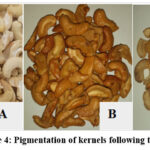 |
Figure 4: Pigmentation of kernels following treatment |
Effects of heat treatment on the biochemical composition of cashew kernels
The moisture, ash, protein, fat, carbohydrate and energy contents of the processed cashew kernels are shown in Table 2. In the case of roasted kernels, those from Gaoua had the highest protein, fat and carbohydrate contents, and the highest energy value, at 18.57g, 40.81g, 13.63g and 496.09 kcal/100g respectively. Almonds from Bobo-Dioulasso, on the other hand, had the highest water content and those from Banfora had the highest ash content, at 1.79% and 2.87% respectively. Banfora almonds had the lowest water content, fat content and energy value, at 1.37%, 36.96g and 458.07 kcal/100g respectively, while Bobo Dioulasso almonds had the lowest ash, protein and carbohydrate content, at 2.73%, 15.78g and 10.99g respectively. The difference was significant for fats (p = 0.035).
In the case of fried almonds, the highest moisture, fat and carbohydrate contents, as well as the highest energy value, were obtained by almonds from Gaoua, with levels of 1.72%, 42.4g, 13.72g and 500.9 kcal/100g. Almonds from Banfora had the highest ash content, at 2.61%, while those from Bobo-Dioulasso had the highest protein content, at 16.68g. Bobo-Dioulasso almonds had the lowest water content, fat and carbohydrate content, and the lowest energy value, at 1.45%, 39.26g, 10.43g and 461.72 kcal/100g respectively. Gaoua almonds, on the other hand, had the lowest ash and protein contents, at 2.45% and 16.11g respectively. A comparison of carbohydrate values showed a significant difference (p = 0.008)
Table 2: Nutritional composition of cashew kernels after heat treatment.
|
Type of almonds |
Coding |
Moisture (%) |
Ash (%) |
Fat (g) |
Protein (g) |
Carbohydrate (g) |
Energy value (kcal/100g) |
|
Roasted almonds |
RABa |
1.37±0.86a |
2.87±0.12a |
36.96±3.32 ab |
18.4±4.11a |
12.96±2.54ab |
458.07 |
|
RABo |
1.79±0.29a |
2.73±0.13a |
40.6±1.91a |
15.78±2.77a |
10.99±2.15ab |
472.5 |
|
|
RAGa |
1.69±0.50a |
2.8±0.06a |
40.81±3.13a |
18.57±5.88a |
13.63±2.12a |
496.09 |
|
|
p-value |
0.413 |
0.169 |
0.035 |
0.421 |
0.102 |
– |
|
|
Fried almonds |
FABa |
1.53±0.74a |
2.61±0.08a |
40.74±5.15a |
16.54±1.33a |
13.19±2.23a |
485.59 |
|
FABo |
1.45±0.73a |
2.55±0.09a |
39.26±6.72a |
16.68±3.52a |
10.43±1.58b |
461.72 |
|
|
FAGa |
1.72±0.61a |
2.45±0.16a |
42.4±5.86a |
16.11±0.46a |
13.72±1.22a |
500.9 |
|
|
p-value |
0.760 |
0.251 |
0.611 |
0.889 |
0.008 |
– |
Values are presented as the means ± MSD (mean standard deviation); Values in the same column with different superscript letters are significantly different at the 5% threshold. RABa: Roasted Almonds from Banfora; RABo: Roasted Almonds from Bobo-Dioulasso; RAGa: Roasted Almonds from Gaoua, FABa: Fried Almonds from Banfora; FABo: Fried Almonds from Bobo-Dioulasso; FAGa: Fried Almonds from Gaoua
Effects of heat Treatment on nutritional parameters of cashew kernels
The results for Banfora kernels are shown in Figure 5. Regarding carbohydrate content, there was no significant difference between the treated samples and the control. However, for the other parameters, such as moisture, protein and fat content, there was a significant difference (p<0.05) between the control and treated kernels. Moisture content fell sharply after the treatments, by 74.46% after roasting and 71.33% after frying. Ash content did not vary significantly after roasting but showed a greater reduction of 10.80% after frying. Protein content fell by 29.09% after roasting, compared with 36.25% after frying. As for fat content, a non-significant reduction was obtained after both treatments, with a rate of 5.19% after frying and 13.99% after roasting. Carbohydrate content, on the other hand, increased after the various treatments, rising by 14.22% for fried almonds and 12.25% for roasted almonds.
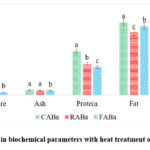 |
Figure 5: Changes in biochemical parameters with heat treatment of Banfora almonds |
In the case of Bobo-Dioulasso almonds, the treatments also led to variations in nutritional parameters (Fig. 6). The results obtained showed a significant variation in moisture and protein content. Moisture content fell by 71.21% for fried almonds and 64.37% for roasted almonds, while protein content fell by 38% for roasted almonds and 34.47% for fried almonds. Ash content also showed a non-significant reduction of 5.34% after frying. Fat content decreased slightly (3.94%) on roasted almonds compared with fried almonds (7.12%). As for carbohydrate content, an increase of 33.76% for roasted almonds and 26.82% for fried almonds was also obtained.
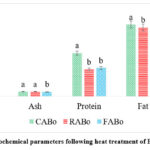 |
Figure 6: Changes in biochemical parameters following heat treatment of Bobo Dioulasso almonds |
For Gaoua almonds, the results showed a significant difference (P <0.05) in moisture and protein content after the treatments (Fig. 7). Roasted almonds showed a reduction in moisture and protein content of 68.45% and 46.5% respectively. Similarly, the moisture and protein content of fried almonds fell by 68.91% and 38.33% respectively. Ash content did not vary significantly, but roasted almonds showed a reduction of 11.24%. Fat content fell by 1.69% for roasted almonds and by 5.37% for fried almonds. Carbohydrate content, on the other hand, increased by 18.38% for roasted almonds and by 17.60% for fried almonds.
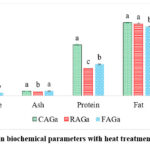 |
Figure 7: Changes in biochemical parameters with heat treatment of Gaoua almonds |
Impact of heat treatment on the energy value of Almonds
Figure 8 shows the decrease in energy value for all samples from different localities. For the Banfora and Gaoua samples, energy values varied respectively from 536.71 to 458.07 kcal/100g and from 554.93 to 496.09 kcal/100g, with the greatest decrease in energy value observed for roasted almonds. For almonds from Bobo-Dioulasso, the energy value varied from 515.05 to 461.72 kcal/100g, with the greatest loss in energy value observed for fried almonds.
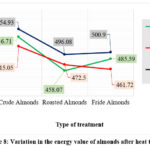 |
Figure 8: Variation in the energy value of almonds after heat treatment |
Discussion
The results of the nutritional analyses showed that cashew kernels sold in bulk on the market are rich in ash, protein and fats, and have a high energy value. Depending on the locality, some variations in the nutritional composition of the almonds were observed. These observed differences in the nutritional composition are thought to be due to environmental factors 18, storage and handling processes, cultivation and harvesting methods and conditions 19. Particularly for protein content, differences between almonds from different localities could be due to the nature of the soil, growing conditions, but also the stage at which the fruit is picked 20. The moisture content of almonds from all three localities was above the specifications of the CEE-ONU, (2012) 21 which suggests moisture contents below 5%. Moisture content was also higher than those reported by other authors, with a rate of 3.16% and 3.8% 6,5. On the other hand, they were close to those reported by an earlier study with a rate of 5.7% 8. From one locality to another, water contents showed variations which could be due to the poor application of nut drying techniques after collection in the various orchards and to poor storage conditions having favored the re-wetting of certain nuts. The ash content of almonds from the three localities showed similar trends, ranging from 2.33% to 2.93%. These ash contents were similar to those reported by Venkatachalan and Sathe (2006) 9, with a rate of 2.66%. However, Aremu et al. (2006) 8 reported higher ash contents than those in the present study, with a rate of 4.4% on cashew nut flours of the Sabo Farm near Nasarawa State Polytechnics, Lafia. The kernels in the present study were particularly rich in protein, with the highest levels obtained in Gaoua kernels (30.11%). The protein content of almonds from Bobo-Dioulasso was similar to that reported by Aremu et al. (2006) 8 and Minh et al. (2019) 22, with a rate of 25.3% and 26.35% respectively. However, the protein contents obtained in the present study were higher than those reported by Venkatachalan and Sathe, (2006) 9 and Rico et al. (2016) 5, with a rate of 18.81% and 21.3%. As proteins play a very important structural and functional role in the body, the high protein contents obtained in cashew kernels show that their consumption could help compensate for nutritional protein deficits. Almonds in the present study were also characterized by high-fat content. The values obtained were higher than those found by Akinkanmi and Atasie, (2008) 7, with an average of 49.1%. However, the values obtained in this study are lower than those reported by Trox et al. (2010) 23, with a rate of 66.21%. The fats contained in cashew nuts are of good quality for consumption, as one study showed a high presence of monounsaturated fatty acids, notably with 20% of linoleic acid and 60% of oleic acid in cashew nut fat 7. Compared to the work of Dakuyo et al. (2022) 24 whose fat contents were in the order of 50.42%, the cashew kernels in this study showed lower fat conten. Carbohydrate content was low in this study compared with those previously reported by Semporé et al. (2021) 19 on a collection of cashew (Anacardium occidental L.) accessions under selection in Burkina Faso, and those reported by Dakuyo et al. (2022) 24 on cashew nuts from different geographical areas of Burkina Faso.
The heat treatments applied to cashew kernels resulted in changes in coloration from white to golden yellow. This phenomenon can be explained by the effect of the relatively high temperature that led to browning. At high temperatures, carbohydrates and water react to produce caramel. Thus, when the moisture content is substantially reduced, carbohydrates and amino acids react to develop flavors through the two distinct mechanisms of Maillard browning (or Maillard reaction) and caramelization. Previous studies have shown high carbohydrate levels in cashew kernels indicating the potential for a browning reaction 25,19.
Roasting and frying contributed to variations in the nutritional quality of cashew kernels. In addition, frying led to a greater reduction in protein content. Moisture content fell considerably after the various heat treatments. The heat undergone by the kernels during roasting and frying resulted in a significant loss of water in the kernels due to evaporation. Other authors, notably Pambou-tobi, (2019) 26 and Krokida et al. (2000) 27, also reported that the variation in moisture content was remarkable with increasing temperature during dry heat treatments (roasting, frying). Regarding ash content, the results obtained in this study showed that there was no great difference between the control and treated samples. These results corroborate those of Tshite et al. (2015) 28, who had shown in their study that heat treatments did not influence ash content. For all samples, the protein content of cashew kernels subjected to both treatments decreased significantly. This decrease could be explained by protein denaturation due to the action of heat 29 and caramelization during the Maillard reaction 30. In most roasted almonds, fat content decreased slightly. This may be due to a loss of fat during roasting, as heat weakens cell membranes, allowing the release of intracellular fat 31. In the case of fried almonds, a higher fat content than that of roasted almonds and some control almonds was obtained, which could be explained by the absorption of frying oil by the almonds. Indeed, during frying, partial or total dehydration occurs thanks to the simultaneous transfer of mass and energy 32,33,34. According to many authors, this dehydration results in the loss of water from the feed and the simultaneous absorption of oil 35,32. According to other authors, these two mass transfers are usually well correlated 36,32. Regarding carbohydrate content, the results showed a slight increase during the various treatments carried out on cashew kernels. The increase in total carbohydrate content during heat treatment could be explained by the modification of dietary fiber structure during cooking, with the release of less complex polysaccharide molecules 37. The energy value of roasted and fried almonds was lower than that of crude almonds in all three localities. This phenomenon is simply the result of lower protein and fat content after the various treatments. The results obtained in this study corroborate those obtained by other authors in Côte d’Ivoire. Indeed, the study by N’Cho et al. (2022) 38 on the Influence of Heat Treatment on the Nutrient Profile of Cashew Kernel Milk showed an improvement in the nutritional quality of Cashew Kernel Milk following heat treatment at 98°C for 45 minutes.
Overall, the results of this study showed that the heat treatments applied to cashew kernels resulted in a slight decrease in water, protein and fat content. On the other hand, an increase in carbohydrate content was obtained. This increase in carbohydrate content is an excellent discovery for the use of this resource in the dietary balance much appreciated by local populations.
Conclusion
The physicochemical and nutritional characterization of nuts from the three localities showed that almonds have high protein, fat and carbohydrate contents. Samples from Gaoua had the highest protein and fat content. The various treatments applied to the almonds resulted in reductions in water, protein and fat content and an increase in carbohydrate content. To better know the effect of heat treatment on cashew kernels, it would be important to extend this study by determining the new molecules formed.
Acknowledgment
The authors would like to thank all the participants who contributed to this study. The authors thank also the ISP/IPICS/RABIOTECH project at University Joseph KI-ZERBO.
Conflicts of Interest
The authors declare no conflict of interest.
Funding Sources
This research did not receive specific funding from public, commercial or non-profit funding agencies.
References
- Asogwa EU, Hammed LA, Ndubuaku TCN. Integrated production and protection practices of cashew (Anacardium occidentale) in Nigeria. African J Biotechnol. 2008;7(25):4868-4873. doi:10.4314/ajb.v7i25.59681
- Dendena B, Corsi S. Cashew, from seed to market: A review. Agron Sustain Dev. 2014;34(4):753-772. doi:10.1007/s13593-014-0240-7
CrossRef - Kolliesuah NP, Saysay JL, Zinnah MM, Freeman TA, Chinenye D. Trend analysis of production, consumption and export of cashew crop in West Africa. African Crop Sci J. 2020;28:187-202. doi:https://dx.doi.org/10.4314/acsj.v28i1.14S.
CrossRef - INSD. (Institut national de la statistique et de la démographie). Annuaire statistique 2019. In: ; 2020:335.
- Rico R, Bulló M, Salas-Salvadó J. Nutritional composition of raw fresh cashew (Anacardium occidentale L.) kernels from different origin. Food Sci Nutr. 2016;4(2):329-338. doi:10.1002/fsn3.294
CrossRef - Oliveira-Sousa AG De, Fernandes DC, Alves AM, Freitas JB De, Naves MM V. Nutritional quality and protein value of exotic almonds and nut from the Brazilian Savanna compared to peanut. Elsevier Ltd. Food Res Int. 2011;44(7):2319–2325.
CrossRef - Akinhanmi TF, Atasie VN. Chemical Composition and Physicochemical Properties Of Cashew nut (Anacardium occidentale) Oil and Cashew nut Shell Liquid. J Agric Food Environ Sci. 2008;2(1):1-10.
- Aremu MO, Olonisakin A, Bako DA, Madu PC. Compositional studies and physicochemical characteristics of cashew nut (Anarcadium occidentale) flour. Pakistan J Nutr. 2006;5(4):328-333.
CrossRef - Venkatachalan M, Sathe SK. Chemical composition of selected edible nut seeds. J Agric Food Chem. 2006;54(13):4705-4714. doi:10.1021/jf0606959
CrossRef - Kris-Etherton PM, Hu FB, Ros E, Sabaté J. The role of tree nuts and peanuts in the prevention of coronary heart disease: Multiple potential mechanisms. J Nutr. 2008;138(9). doi:10.1093/jn/138.9.1746s
CrossRef - Ros E, Tapsell LC, Sabaté J. Nuts and berries for heart health. Curr Atheroscler Rep. 2010;12(6):397-406. doi:10.1007/s11883-010-0132-5
CrossRef - Bes-Rastrollo M, Wedick NM, Martinez-Gonzalez MA, Li TY, Sampson L HF. Prospective study of nut consumption, long-term weight change, and obesity risk in women. Am J Clin Nutr. 2009;89(6):1913-ç. doi:10.3945/ajcn.2008.27276.
CrossRef - Jenab M, Ferrari P, Slimani N, et al. Association of nut and seed intake with colorectal cancer risk in the European Prospective Investigation into Cancer and Nutrition. Cancer Epidemiol Biomarkers Prev. 2004;13(10):1595-1603.
CrossRef - Ricau P. Connaître et Comprendre LE MARCHE INTERNATIONAL DE L ’ ANACARDE.; 2013.
- MCIA. Le Guide de Transformation de l’anacarde Au Burkina Faso. Projet d’appui à La Commercialisation de Mangue Séchée et de Noix de Cajou Transformé. Ministère Du Commerce, de l’Industrie et de l’Artisanat.; 2017.
- Falade K, Chime J, Ogunwolu S. Water sorption isotherms and heat of sorption of cashew nuts pretreated by different methods. J Fd Agric Env. 2004;2(2):83-87.
- Montreuil J, Spik G. Microdosage de Sucres : Méthodes Colorimétriques de Dosage Des Sucres Totaux. Faculté Des Sciences, Université de Lille France.; 1969.
- Wallis NZ, Bagnan MA, Akossou AYJ, Kanlindogbe CB. Caractérisation morphologique d’une collection de fruits d’anacardier provenant de la commune de Parakou (Bénin). Int J Biol Chem Sci. 2017;10(6):2413. doi:10.4314/ijbcs.v10i6.1
CrossRef - Semporé JN, Songré-ouattara LT, Tarpaga WV, Bationo F, Dicko MH. Comparison of Proximate Composition and Nutritional Qualities of Fifty-Three Cashew Accessions from Burkina Faso. 2021:1191-1203. doi:10.4236/fns.2021.1212087
CrossRef - Hama-ba F, Kaboré R, Dicko MH. Effect of Soil Type on the Nutritional Quality of Groundnut ( Arachis hypogaea L ) in Burkina Faso. 2022;I:1-4. doi:10.18805/LRF-714.Submitted
CrossRef - CEE-ONU. NORME CEE-ONU DDP-16 concernant la commercialisation et le controle de la qualité commerciale des pommes séchées. In: ; 2012:7.
- Minh NP, Pham VT, Vinh TQ, Thuan LQ. Effect of Drying , Roasting and Preservation on Antioxidant of Cashew ( Anacardium Occidentale ) Nut. 2019;11(3):930-934.
- Trox J, Vadivel V, Vetter W, Stuetz W, Scherbaum V, Gola U. Bioactive compounds in cashew nut (Anacardium occidentale L.) kernels: effect of different shelling methods. J Agric Food Chem. 2010;58(9):5341–6. doi:10.1021/jf904580k.
CrossRef - Dakuyo R, Konaté K, Sanou A, et al. Comparison of Proximate and Phytonutrient Compositions of Cashew Nuts and Apples from Different Geographical Areas of Burkina Faso. 2022.
CrossRef - Stadlmayr B, Charrondiere UR, Enujiugha VN, et al. West African Food Composition Table.; 2012.
- Pambou-tobi N. Influence des conditions de friture profonde sur les propriétés physicochimiques de la banane plantain Musa AAB “ harton ” : étude du vieillissement des huiles et modélisation des transferts de matière au cours du procédé. In: ; 2019:234.
- Krokida MK, Oreopoulou V, Maroulis ZB. Effect of frying conditions on shrinkage and porosity of fried potatoes.43(3), 147‑154. J Food Eng. 2000;43(3):147-154.
CrossRef - Tshite FN, Mulamba VT, Ndianabo MJT. Formulation of precooked flour basic on maize ( Zea mays ) and soya beans ( Glycine max ) by traditional method. Int J Biol Chem Sci. 2015;9(6):2608-2622.
CrossRef - Yaacoub R. Nutritional and sanitary impact of nuts and seeds roasting : the interest of using fluorescence spectroscopy as a tool to control neoformed compounds To cite this version : HAL Id : pastel-00005932. 2010.
- Machiels D, Istasse L. La réaction de Maillard: Importance et application en chimie des aliments. Ann Méd Vét. 2002;(146):347-352.
- Mateos GG, Salado S. Derniers Développements Dans l’utilisation Du Soja Graine Entière Destinés à La Volaille.; 1999.
- Adedeji AA, Ngadi MO, Raghavan GS V. Kinetics of mass transfer in microwave precooked and deep-fat fried chicken nuggets. J Food Eng. 2009;9(1):146-153.
CrossRef - Farinu A, Baik OD. Deep fat frying of foods-transport phenomena. Food Rev Int. 2005;21(4):389-410.
CrossRef - Debnath S, Rastogi NK, Krishna AGG, Lokesh BR. Effect of frying cycles on physical, chemical and heat transfer quality of rice bran oil during deep-fat frying of poori: An Indian traditional fried food. Food Bioprod Process. 2012;90(2):249‑256.
CrossRef - Gazmuri AM, Bouchon P. Analysis of wheat gluten and starch matrices during deep-fat frying. Food Chem. 2009;115(3):999-1005.
CrossRef - Vitrac O, Dufour D, Trystram G, Raoult-Wack AL. Characterization of heat and mass transfer during deep-fat frying and its effect on cassava chip quality. J Food Eng. 2002;53(2):161-176.
CrossRef - Nafir-Zenati S, Gallon G, Faver J. Effet de la Cuisson sur la Teneur en Minéraux des Epinards. ORSTOM. 1993:7.
- Cho CN, Soro D, Yeo MA, Koffi EK. Influence of Heat Treatment on the Nutrient Profile of Cashew Kernel Milk ( Anacardium occidentale L .). 2022;10(1):58-64. doi:10.12691/jfnr-10-1-8
CrossRef

This work is licensed under a Creative Commons Attribution 4.0 International License.






